Mayumba, Gabon to Conkouati, Congo
After finishing my surveys in southern Banio Lagoon, I returned to Mayumba for several days to interview fishermen and survey several rivers at the north end of the lagoon. I also worked with Jean Nestor and Chardene, the WCS outreach team, on manatee presentations for villages. Mayumba has a much higher human population so manatees are rarely seen (the last one anyone could remember was seen in the Louzibi River North in 2007). They may be around in small numbers, but they are very secretive. The Louzibi River North (there are 2 Louzibi Rivers draining into Banio Lagoon, which makes it complicated when discussing them with local people) has plenty of good manatee habitat, including an open swampy area with lots of plants they eat, but unfortunately there were no signs of them.
Some of the trees had funky twisted roots that wound at their bases like sculpture.
The second river we surveyed in the north, the Doumvou, quickly got very narrow. No manatees were seen there either, but they may have been hunted out a long time ago.
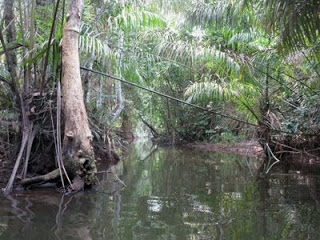 A few days later I took a local boat to the southern end of Banio Lagoon, a 4 hour trip. The boat was loaded with thousands of pounds of rice and beer, and 13 passengers. We stopped at every village on the lagoon to offload people and supplies, and finally arrived at the small town of Ndindi. Thanks to Jean Nestor in Mayumba who helped me make arrangements, a pickup truck was waiting to take me to a small hostel (which was an experience I won’t soon forget- the entire roof was full of bats and the guano smell so strong that I was convinced the ceiling was going to collapse in on top of me, but there was literally nowhere else in the village to stay). The next morning I rented the same truck (not an inexpensive proposition, but there was no other way to get there, and I ended up taking 3 other paying passengers to help cut the cost) to go through the forest and across the border into the Congo. Before leaving I had to spend an hour at the local border patrol to await the commandante who was finishing his breakfast, then explain to him the purpose of my trip and have my passport info. registered (and pay a small bribe, of course). The “road” was basically a dry riverbed occasionally used by logging company trucks. We bounced over boulders and along sandy embankments from forest to savannah and at one point the driver told me we were entering the Congo. There was no sign to mark the boundary in this very remote area. A short while later we entered the village of Nzambi and went to the border patrol. I had been told they could be very difficult (especially to researchers with lots of equipment), but I was pleasantly surprised and they quickly waved me through without even asking a bribe. I think this definitely had to do with the fact that I told them I was working with Hilde, the director of Conkouati National Park, who is greatly respected in this area. After passing through the checkpoint we drove down a big hill to the edge of Conkouati Lagoon, which is surrounded by hilly savannah that peeks up above the gallery forest all along its edge. My friend Tim, a whale and dolphin researcher, picked me up in a small boat and brought me to the national park headquarters.
A few days later I took a local boat to the southern end of Banio Lagoon, a 4 hour trip. The boat was loaded with thousands of pounds of rice and beer, and 13 passengers. We stopped at every village on the lagoon to offload people and supplies, and finally arrived at the small town of Ndindi. Thanks to Jean Nestor in Mayumba who helped me make arrangements, a pickup truck was waiting to take me to a small hostel (which was an experience I won’t soon forget- the entire roof was full of bats and the guano smell so strong that I was convinced the ceiling was going to collapse in on top of me, but there was literally nowhere else in the village to stay). The next morning I rented the same truck (not an inexpensive proposition, but there was no other way to get there, and I ended up taking 3 other paying passengers to help cut the cost) to go through the forest and across the border into the Congo. Before leaving I had to spend an hour at the local border patrol to await the commandante who was finishing his breakfast, then explain to him the purpose of my trip and have my passport info. registered (and pay a small bribe, of course). The “road” was basically a dry riverbed occasionally used by logging company trucks. We bounced over boulders and along sandy embankments from forest to savannah and at one point the driver told me we were entering the Congo. There was no sign to mark the boundary in this very remote area. A short while later we entered the village of Nzambi and went to the border patrol. I had been told they could be very difficult (especially to researchers with lots of equipment), but I was pleasantly surprised and they quickly waved me through without even asking a bribe. I think this definitely had to do with the fact that I told them I was working with Hilde, the director of Conkouati National Park, who is greatly respected in this area. After passing through the checkpoint we drove down a big hill to the edge of Conkouati Lagoon, which is surrounded by hilly savannah that peeks up above the gallery forest all along its edge. My friend Tim, a whale and dolphin researcher, picked me up in a small boat and brought me to the national park headquarters.
The logo of Conkouati national park is the manatee!
As we approached from the lagoon, I could see the park buildings on the savannah at the top of a hill. This is my first time here, and mine will be the first manatee surveys in many years.
Hilde & Tim’s wonderful house sits at the top of the hill…
…with a beautiful view of the savannah and lagoon below. In the morning I hear chimps calling from the forest, and at sunset we saw buffalo grazing on a nearby hillside.
The savannah is dotted with termite mounds that resemble giant mushrooms.
This is Hilde and her 3 dogs when we went on my first kayak excursion on the lagoon.
This coastal lagoon has habitat ranging from mangroves and lots of Crinum natans near the ocean, to lowland forest up the rivers.
Crinum natans are gorgeous flowers and much more of a true water lily than the lotus that are regularly called water lilies.
On my second day I accompanied two park employees up a river to release 2 Dwarf crocodiles that had been confiscated from poachers. This gave me my first opportunity to see the riverine habitat. No hunting or fishing is allowed on the river and there were no camps. Elephant trails were everywhere and the habitat was great for manatees.
One of the Dwarf crocs, just prior to release.
Now that I have a better understanding of the layout of the lagoon, it’s time to survey for manatees!!

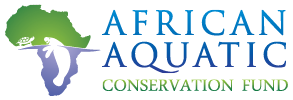

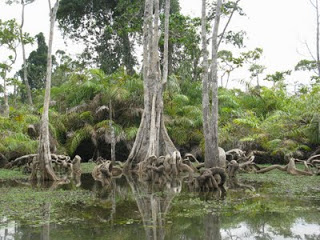
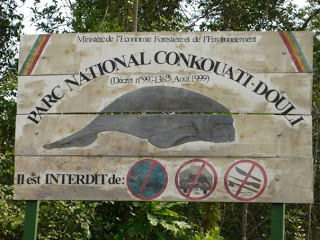
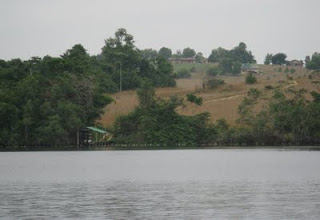
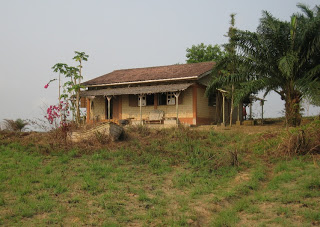
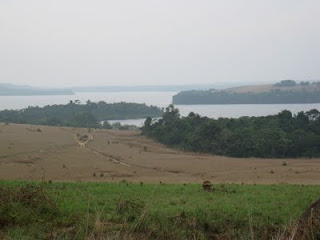
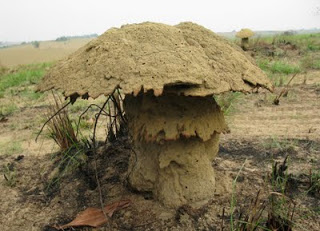
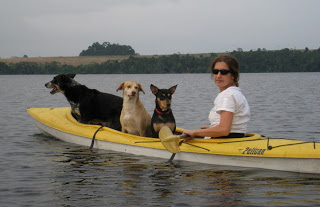
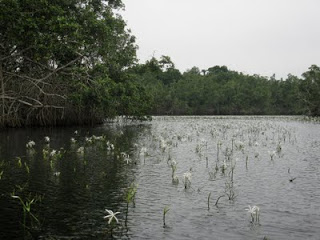
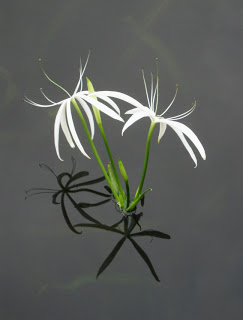
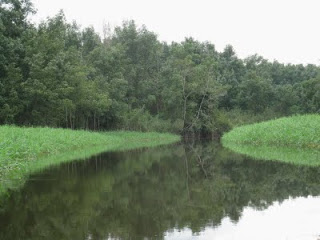
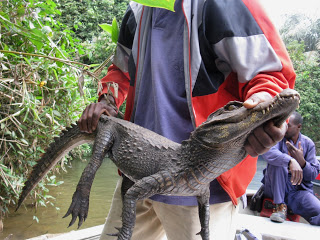

Toni
July 7, 2011 at 8:24 amLucy
Your blog is the best. I love the updates on Victor. I love reading all about your adventerous travels. Can't wait for the next update.
Toni
Lucy
July 7, 2011 at 8:27 amThanks Toni! That's very sweet of you. More news coming soon- I'm heading out to a remote area to camp & search for manatees early next week.
Anonymous
July 15, 2011 at 2:12 pmHi Lucy!
I'm really enjoying your blog. Really fascinating!
Maranda (from KP)
Anonymous
October 30, 2011 at 3:45 pmThere is a fantastic picture of termite mound resembling a mushroom. Can you send me some original pictures of them. I am a termite researcher in Philippines.
Thanks
Partho Dhang
pdhang@pest-science.com